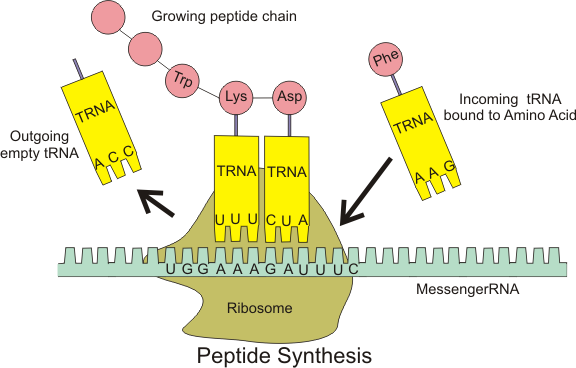Protein Synthesis
The idea that DNA makes RNA and RNA makes protein is sometimes referred to as the central dogma of molecular biology; the term was coined by Francis Crick, one of the co-discoverers of DNA's structure.
1. From DNA to RNA: How does the information in the DNA molecule get turned into the proteins that give our bodies structure? We won't go into this in great detail but, to give a big picture overview, here's what happens: DNA, which is a double stranded molecule, unzips down the center through the action of an enzyme called RNA polymerase. An RNA template is laid down on top of one of the DNA strands, making a near mirror image (instead of Thymine, RNA uses Uracil) of the DNA code, as shown in the table below. This template is laid down in the 5' to 3' direction. (Remember that the strands are anti-parallel.) The RNA strand is now called messenger RNA, or mRNA, and leaves the nucleus of the cell. This process of converting DNA information into RNA information is called transcription.
| Whenever the DNA had this nucleotide base... | the RNA will have this nucleotide base |
| Cytosine (C) | Guanine (G) |
| Guanine (G) | Cytosine (C) |
| Adenine (A) | Uracil (U) |
| Thymine (T) | Adenine (A) |
2. From RNA to Amino Acid: The mRNA arrives at a ribosome. Each three letter snippet of RNA is called a codon. The RNA codons are read by the ribosome. Each codon calls for the synthesis of a particular amino acid. There are about 20 biologically important amino acids. Read the table below from left to right to look up the amino acid that is called for by each codon. For example, if the RNA codon reads "CAG," the amino acid that will be synthesized is Glutamine. If the RNA codon reads "ACG," the amino acid that will be synthesized is Threonine. (Note that, in some cases, there is more than one codon that will result in the same amino acid.) As the ribosome moves across the mRNA strand, reading the 3-letter codons, a special transport molecule called transfer RNA (tRNA) is dipatched to pick up the amino acid specified by the codon. The tRNA delivers the correct amino acid back to the ribosome, lands on the mRNA codon (the tRNA molecule has a corresponding anti-codon), and releases its amino acid cargo, where it is attached to a growing peptide chain. This process of converting RNA information into amino acids is called translation.
